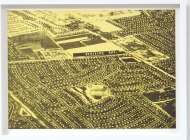Richard Forster: Levittown
Date uploaded: March 9, 2016
Levittown is Richard Forster’s major new commission for De La Warr Pavilion, responding to the Modernist architecture of the building through a neon installation and over fifty drawings on paper. The new work has evolved from Forster’s extensive research into an archive of found images, plans and drawings of Levittown, the pioneering American suburban housing project of 1947, first built in Long Island and developed further in New Jersey and Pennsylvania.
Levittown highlights the complicated relationships characteristic of a particularly American time and place, and is a timely dialogue with the pioneering European modernity evident in the architecture of the De La Warr Pavilion: a dialectic between hope and failure, vision and compromise, individualism and socialism.
Comprising a suite of four nine-part grids of graphite and watercolour drawings and twenty individual works, Forster’s drawings for Levittown present a remarkable melding of realism and abstraction in images that strongly resemble their photographic source material yet take on a heightened quality through a slow concentrated process. In each of the grid works, a drawing of an idealised American family member is placed at the centre of nine aerial views that deomstrates the magnitude and vast scale of the Levittown housing scheme. Forster’s composition does much to dramatise the defiance of the individual and the human in what constitutes a radically abstract terrain of repetition and seriality in built form.
An unsettling combination of visionary and ideological pragmatism, Levittown is a subject that expands Forster’s previous interests in social experiments and breakthroughs in architecture. This includes compelling work on the Bauhaus and the German Democratic Republic questioning how architectural environments impact on politics, culture and memory, and Levittown includes a GDR inspired wallpaper work. The work also alludes to Little Boxes, the folk song made famous by Peter Seeger in 1963 that captured a sense of the growing counter-culture movement against the forced conformity of suburban life.
In the 1950s Levittown offered the opportunity for home-ownership to thousands of families with their affordable houses in the years of severe housing shortage following World War II. They were designed to meet the aspirations of a modern age, providing families with the domestic equivalent of the American dream. Formulaic in its approach, each of the mass-produced homes came with built-in TV and hi-fi, took under 20 minutes to erect, cost just US$7,990 and could be secured with a 5% down payment. The scheme’s opposers decried the apparent racial segregation of the communities, the crushing uniformity of the town and the psychological effects such conformity could have on the hopes and dreams of people living and growing up in the suburbs.
Forster nurtured his drawing copying posters of popstars during formative years he describes as an ‘anxious teenager alienated in an English suburban bedroom’. While his intimate and compulsive attention to detail could be categorised and mistaken for photo-realism, Forster prefers to use more ambiguous categories such as the ‘nearly-photo-realistic’ or the ‘photocopy-realistic’, in an attempt to extend the reading of the work towards the meanings inherent to the medium of drawing, and the particular subject-matter of his choosing.
De la Warr Pavilion
Gallery 2
26th of March to the 5th of June 2016
For further information, images and interviews please contact Janette Scott Arts PR on [email protected] or 07966 486156 or click here.

